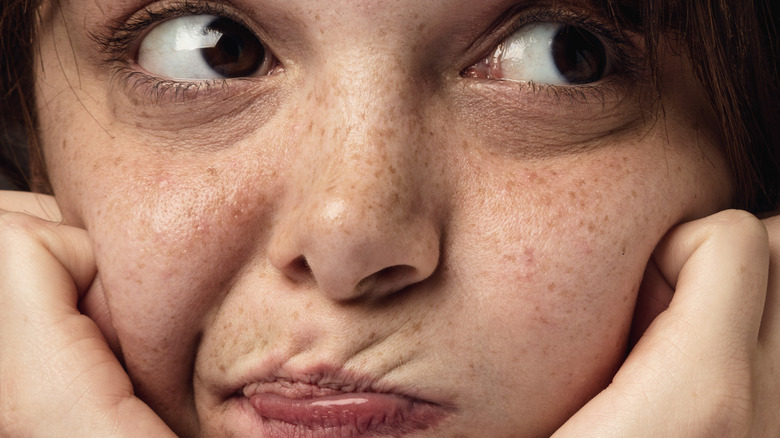
Fiber Could Help You Lose Face Fat Quickly (But There’s A Catch) – Health Digest
Do you feel like your face has gotten puffier due to excess fat? You may be able to reduce your facial fat fairly quickly by incorporating more fiber into your diet. Why fiber? The Mayo Clinic notes that fiber helps with digestion, making it a great ally for your gut and gastrointestinal system. Additionally, fiber leaves you feeling fuller for longer. That’s a primary reason why those trying to shed pounds often turn to fiber-rich foods. As their fiber intake increases, their perceived satiety typically increases as well.
In a 2022 review published in Critical Reviews in Food Science and Nutrition, the author notes that clinical trials have repeatedly proven that increasing fiber can lead to a decrease in body weight. Specifically, the review explains that “randomized controlled trials have shown reductions in energy intake and body weight along with increased satiation and reduced hunger following consumption of fibers.”
Where does the face fat and fiber connection come in? As you start to lose weight due to an uptick in your fiber consumption (along with the adoption of other healthy eating habits), you may begin to notice that your face starts to appear leaner. This won’t happen overnight, but it can happen relatively soon if you’re shedding pounds consistently. However, there’s a caveat: The amount of facial fat reduction you experience will probably have a lot to do with your genetics. Accordingly, you may not see much of an outcome if your body is pre-programmed toward a rounder, fuller face shape.
Facial fullness may have heritage connections
When asked whether fiber can contribute directly to a person’s amount of facial fat, Dr. Amy Lee, head of nutrition for Nucific, explains that fiber doesn’t reduce fat in the face. Nonetheless, she agrees that “eating a lot of fiber can result in weight loss which can contribute to slimming of the face [or] cheek area.” Lee continues by explaining that fat distribution is a very individual phenomenon. “Some people would say that when they lose weight, they see it on the face first and others would argue that the weight loss is seen elsewhere,” she says. “It really depends on the person.”
A 2019 study published in Aesthetic Plastic Surgery supports Lee’s assertion. The study examined the role of facial cheek fat distribution as related to subject sex, age, and BMI rating. The researchers concluded that each of those factors played a role in predicting how much cheek fat an individual would have.
In other words, you might not see a major change in the amount of facial fat if you eat more fiber and get leaner. Nonetheless, it may be worth losing weight by upping your fiber intake, even if you’re mostly concerned with facial fat rather than with body fat. Alternatively, you may want to explore medical esthetic treatments to target facial fat if that’s your only goal. In that circumstance, you may want to investigate two of Lee’s esthetic treatment suggestions, which are laser and radiofrequency therapies.
Moving to a fiber-rich diet
Let’s say that you’ve decided to go the fiber route to achieve a slimmer face. If you’re interested in eating a fiber-heavy diet, start by incorporating more fibrous foods into your meals and snacks. Typically, produce items contain a lot of soluble fiber. Soluble fiber is superior to insoluble fiber when it comes to promoting weight reduction and maintenance. Not sure which foods to start with? In a Healthline article outlining the foods containing the most fiber, pears, strawberries, lentils, oats, popcorn, apples, pistachios, sweet potatoes, and artichokes top the list.
According to a 2022 article found in BMJ, adults should eat at least 25 to 30 grams of fiber daily. For perspective, Healthline data reveals that a medium-sized apple contains 4.37 grams of fiber. That means one apple is the equivalent of about one-eighth of the recommended daily fiber consumption for someone over 18 years old.
On days when you fall short of your fiber goal, consider taking a fiber supplement. Just be sure to speak with your medical provider about increasing your fiber if you are taking antidepressants, drugs to combat diabetes, carbamazepine, cholesterol-fighting medications, digoxin, or lithium, as Mount Sinai cautions that fiber supplements can interfere with these prescriptions.
Trim down your sodium to reduce facial bloat
Are you someone who always likes extra tips to solve your health issues? You’ll appreciate knowing that decreasing your sodium while increasing your fiber might also be beneficial to get a leaner-looking face.
The more sodium you take in, the more water you’re likely to retain. While water retention is frequently associated with the belly or legs, it can happen in the face as well. MedicalNewsToday explains that eating salty foods before bedtime can lead to early morning facial puffiness. Therefore, a possible solution to consistent bouts of facial bloat upon awakening could be as simple as avoiding overly processed foods at night.
What salt-laden foods should you pass by as your go-to evening treats? Healthline mentions several that are best skirted if you want a face that looks as slender as possible. They include ramen noodles, cheese, salty snacks, French fries, alcohol, and high-sodium dips and toppings (e.g., soy sauce.) Even if you don’t technically have less fat on your face, you’ll appear as if you do.






